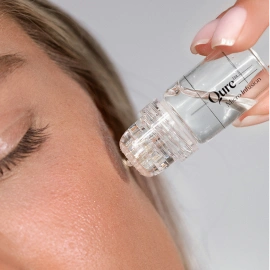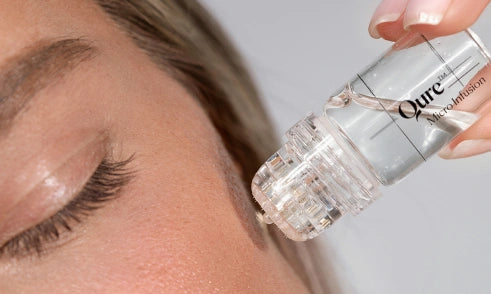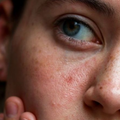One of the most common questions we see is how to clean a derma roller properly, and for good reason. Without the right cleaning routine, you're risking irritation, breakouts, or even infection.
In this article, we'll walk you through the best method to clean your derma roller, what type of alcohol to use, and why keeping it spotless before and after each session is so important.
We'll also compare derma rolling to our Micro Infusion system, a more hygienic and convenient solution for those serious about their skincare results. With our expertise in at-home skincare tools, we've seen what works—and what doesn't—so you can trust you're getting advice backed by real experience.
What this article covers:
- What Is The Best Method For Cleaning A Derma Roller?
- How To Clean A Derma Roller
- Why Is It Important To Clean A Derma Roller Before And After Using It?
- Derma Roller Vs Micro Infusion: Which Is More Sanitary?
- How To Clean A Derma Roller (FAQs)
What Is The Best Method For Cleaning A Derma Roller?
From our experience, the most reliable method for cleaning a derma roller is a two-step approach that focuses on both removing visible debris and eliminating harmful bacteria. The process starts with a thorough rinse to wash away any skin particles, product residue, or dirt. This step helps to prepare the roller for proper disinfection.
Next comes the most important step: disinfection using a sanitizing solution, typically isopropyl alcohol. Soaking the derma roller for 10-15 minutes ensures that pathogens like bacteria and viruses are killed effectively.
This method has become the gold standard for maintaining hygiene with microneedling tools. It's easy, efficient, and helps extend the life of your device while protecting your skin.


Qure recommends
Discover our Best Sellers
What Type Of Alcohol Should You Use For Cleaning A Derma Roller?
With our expertise in at-home skincare, we've found that using 70% isopropyl alcohol is the safest and most effective option for cleaning a derma roller.
This specific concentration strikes a balance between strength and effectiveness. It's strong enough to kill bacteria but doesn't evaporate too quickly, giving it time to sanitize thoroughly. While higher concentrations may seem more powerful, they can dry too fast to properly disinfect.
It's also important to avoid any alcohols with added scents, colors, or oils, as these can cause irritation or leave residue on the needles. Stick with the pure stuff. It's all about giving your skin the safest, cleanest experience possible.

How To Clean A Derma Roller
Step 1: Rinse The Roller
Right after using your derma roller, the first thing you need to do is give it a good rinse under warm running water. This helps wash away any skincare product, skin cells, or tiny particles that may have collected on the needles during treatment.
Hold it under the stream with the needles pointing downward, and rotate it gently so every part gets rinsed. It's a quick but crucial step. Skipping this can lead to buildup that makes later disinfection less effective—and that's not something you want near your face.
Step 2: Disinfect With Alcohol
Once your roller is clean from debris, it's time to kill off the germs. Fill a clean, shallow container with 70% isopropyl alcohol. Make sure the container is wide enough for the roller head to be fully submerged. Then let it soak for at least 10 to 15 minutes.
This isn't the moment to rush. A proper soak gives the alcohol enough time to penetrate and disinfect those tiny needles. It's one of the most important parts of the cleaning process and helps reduce the risk of any unwanted skin reactions.
Step 3: Dry The Roller
After disinfection, it's important to dry your roller the right way. Take it out of the alcohol and give it a gentle shake to remove excess liquid. Lay it on a clean paper towel with the needles pointing up and let it air dry completely.
Avoid using cloth towels—even clean ones—because they can trap bacteria and fibers that you don't want transferring to your roller. Letting it air dry also protects the needles from damage and keeps them sharp and effective.
Step 4: Store Properly
Once your derma roller is completely dry, it's ready for storage. Always place it back in its original case or a clean, dry container designed for storage. This helps protect the delicate needles from dust, bacteria, and accidental damage.
Keep the container in a cool, dry place—somewhere that's out of reach of moisture or curious hands. Proper storage might seem like a minor detail, but it goes a long way in preserving the quality of your roller and ensuring every treatment is as derma roller safe as possible.

Why Is It Important To Clean A Derma Roller Before And After Using It?
Cleaning your derma roller both before and after use is essential to prevent infections and ensure the device's effectiveness. Before use, cleaning removes any contaminants that may have settled during storage.
After use, it eliminates skin cells, blood, and other residues that can harbor bacteria. Neglecting this hygiene can lead to skin irritations, infections, and compromised treatment results.
Derma Roller Vs Micro Infusion: Which Is More Sanitary?
When it comes to cleanliness and safety, there's a clear difference between traditional derma rollers and Qure's Micro Infusion technology. Derma rollers, while popular and effective, rely heavily on manual cleaning.
That means you must thoroughly rinse, disinfect, dry, and store your roller each time you use it. If even one of those steps is rushed or missed, there's a risk of contamination. Contaminated tools can lead to skin irritation, breakouts, or even infections. If your derma roller hurts, it can be a sign of improper cleaning or a low-quality device.
Qure's Micro Infusion system, on the other hand, is designed with hygiene at the forefront. Each Micro Infusion treatment uses single-use, pre-sterilized needles. There's no need to clean or disinfect anything after your session. Just dispose of what you've used, and you're done. It's fast, safe, and hassle-free.
But hygiene isn't the only benefit. With Micro Infusion, you're getting consistent depth and precision with each treatment. In our experience, derma rollers can be uneven, especially if the needles begin to dull over time. That can lead to inconsistent results.

In contrast, Micro Infusion delivers uniform needle penetration and better product absorption every time. The results? Smoother skin, improved texture, and more visible improvements with continued use.
So if you want the peace of mind that comes with sterile, mess-free treatments (and better results overall), Micro Infusion is the clear winner. It's not just a cleaner option. It's smarter skincare.
Conclusion
Keeping your derma roller clean isn't just a good habit—it's essential for safe, effective skincare at home. By rinsing thoroughly, disinfecting with the right type of alcohol, letting it dry properly, and storing it safely, you can make sure your tool stays in top condition and your skin stays happy.
But if all that sounds like a bit too much effort, or if you're after more consistent and reliable results, our Micro Infusion system is the upgrade your routine needs. It's cleaner, simpler, and delivers better outcomes without the hassle.
Ready to level up your skincare? Try Qure Skincare's at-home Micro Infusion today and see the difference for yourself.


Learn more and share your skincare journey
Join Our VIP Community
How To Clean A Derma Roller (FAQs)
Is it safe to share a derma roller with someone else?
No, sharing a derma roller is never safe. Even with cleaning, cross-contamination can still occur. Each user should have their own tool to ensure hygiene and prevent the spread of bacteria or infections.
How long can I keep using the same derma roller?
A derma roller can last about 10 to 15 uses. However, if you notice the needles becoming dull or bent, it's time to replace it to avoid damaging your skin.
Can I use hydrogen peroxide instead of alcohol to clean my derma roller?
While hydrogen peroxide can disinfect, it's not as widely recommended as 70% isopropyl alcohol.
If you want to learn more, why not check out these articles below:
- What to Do Before Microneedling
- Microinfusion
- Post Microneedling
- Types of Microneedling
- Microneedling with Hyaluronic Acid
- Microneedling Dark Spots
- What Age to Start Microneedling
- Microneedling Men
- Microneedling Double Chin
- How to Get Rid of Acne Scars
- Is Microneedling Safe?
- Is Microneedling Worth It?






















